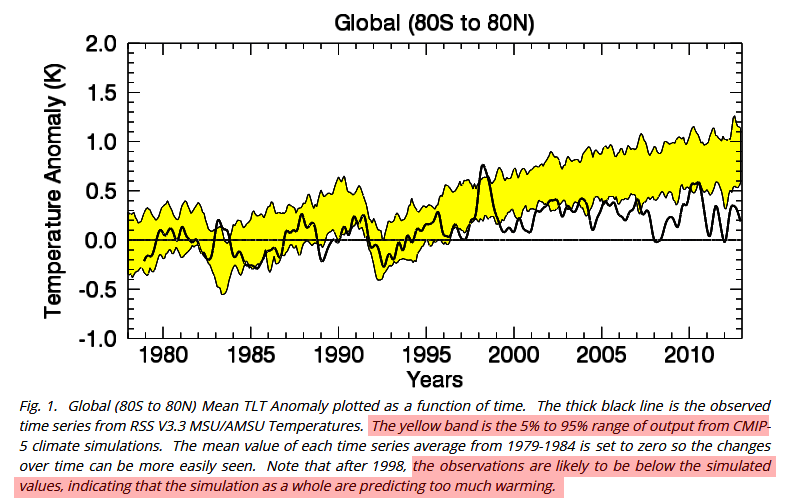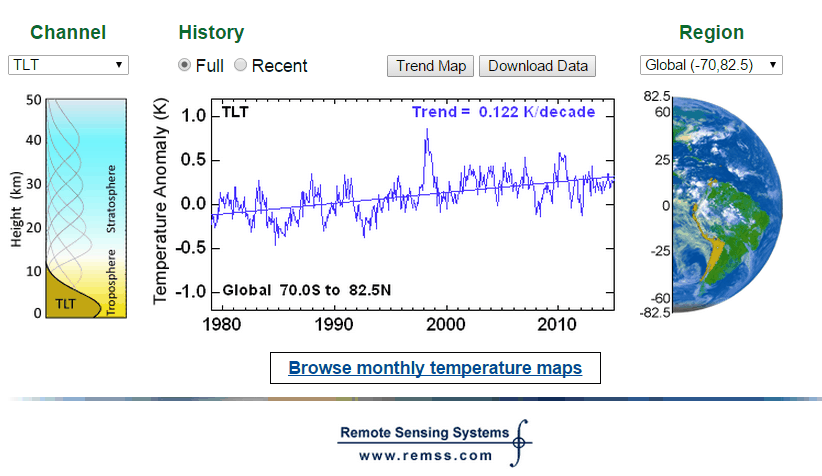Weather and climate agencies around the world have been almost unanimous in declaring 2014 the hottest year on record — something that has promoted considerable chagrin among climate change doubters. That’s because these “skeptics” have long sought to cast doubt on man-made global warming by pointing to an alleged global warming “pause” or “slowdown” — going on to suggest that the computerized climate models that scientists use to project future temperatures are flawed, and overestimate carbon dioxide’s warming effect.
So, is that true? Do the models consistently overestimate the warming effects of greenhouse gases like CO2?
As a recent study suggests, the answer is no. While many models didn’t predict the relatively modest surface-warming “hiatus,” it’s not because they’re biased in favor of greenhouse-gas emissions’ warming effects. Rather, researchers report in Nature, these computer simulations just struggle to predict “chaotic” (or random) short-term changes in the climate system that can temporarily add or subtract from CO2 emissions’ warming effects.
No, climate models aren’t exaggerating global warming – The Washington Post
Impressive pack of lies for three paragraphs. Climate models are far outside the 95% confidence band, 2014 temperatures were nowhere near a record, and there has been no warming for almost 20 years.
The “weather agencies” are the climategate collaborators, all ignored more accurate satellite data, and all use approximately the same set of hand-picked tampered UHI infected data.




“So the researchers tested how 114 model simulations that underpin last year’s assessment report of the U.N. Intergovernmental Panel on Climate Change (IPCC) performed — not just for the 15-year period from 1998-2012 but for all 15-year periods stretching back to 1900. If this analysis were to show that models consistently overestimated or underestimated the amount of warming that actually occurred, then they must have some sort of systematic bias.
So, it’s true that the IPCC model runs didn’t predict the recent warming slowdown. But as these findings show, they didn’t accurately predict certain other 15-year periods of warming accelerations or slowdowns in the past either, and it’s not because they were always overestimating warming. Indeed, in some 15-year periods, the models underestimated warming. Essentially, that means climate skeptics are cherry-picking when they point out that climate models didn’t predict the recent 15-year hiatus.”
Otherwise the models “predicted” the past (known) temperatures better than future temperatures.
I am surprised that hindcasts weren’t 100% correct!
You cannot get 100% correct when you keep changing the past.
They are running scared. It is definitely getting colder. It is painfully obvious to all of us who live in the belt where glaciers rule during the Ice Ages.
As the snow piles higher, as temperatures drop here in the US as well as Europe, this propaganda will collapse like a balloon popped by cacti.
Dear Quaesoveritas: they ‘predict the past’ by ALTERING THE DATA so it lies! They cool down the past and up the temperatures of the present.
The entire point of this news service here is endless proof of the tampering going on.
Actually I find it funny the way RSS keeps trying to fit a straight line through that TLT graph of theirs as if to show a trend. Its beyond ridiculous. LOL (ie no trend before 2000 and none after the graph, its FLAT).They should try a best fit curve me thinks
Steve/Tony, may I suggest you (and others here) read this thesis by a KNMI GCM modeller, The Robustness of the Climate Modelling Paradigm, Ph.D. thesis by Alexander Bakker from The Netherlands
http://dare.ubvu.vu.nl/handle/1871/52184 (click on complete dissertation for complete thesis in PDF)
A short preview;
In 2006, I joined KNMI to work on a project “Tailoring climate information for impact assessments”. I was involved in many projects often in close cooperation with professional users.
In most of my projects, I explicitly or implicitly relied on General Circulation Models (GCM) as the most credible tool to assess climate change for impact assessments. Yet, in the course of time, I became concerned about the dominant role of GCMs. During my almost eight year employment, I have been regularly confronted with large model biases. Virtually in all cases, the model bias appeared larger than the projected climate change, even for mean daily temperature. It was my job to make something ’useful’ and ’usable’ from those biased data. More and more, I started to doubt that the ’climate modelling paradigm’ can provide ’useful’ and ’usable’ quantitative estimates of climate change.
After finishing four peer-reviewed articles, I concluded that I could not defend one of the major principles underlying the work anymore. Therefore, my supervisors, Bart van den Hurk and Janette Bessembinder, and I agreed to start again on a thesis that intends to explain the caveats of the ’climate modelling paradigm’ that I have been working in for the last eight years and to give direction to alternative strategies to cope with climate related risks. This was quite a challenge. After one year hard work a manuscript had formed that I was proud of and that I could defend and that had my supervisors’ approval. Yet, the reading committee thought differently
Bakker’s closing statement:
The ’climate modelling paradigm’ is in ’crisis’. It is just a new paradigm we are waiting for.
h/t Judith Currie;
http://judithcurry.com/2015/02/02/questioning-the-robustness-of-the-climate-modeling-paradigm/
Comment from JC;
I seriously doubt that such a thesis would be possible in an atmospheric/oceanic/climate science department in the U.S. – whether the student would dare to tackle this, whether a faculty member would agree to supervise this, and whether a committee would ‘pass’ the thesis.
‘struggle to predict “chaotic” (or random) short-term changes’
They assume there are no chaotic long-term changes. What is their cutoff frequency?
Do they even understand the difference between chaotic and random?
Indeed.
The IPCC says:
I am convinced modelers have no understanding of the implications of chaos.
Bobby, if they did they would give it up as a useless waste of time. Since they were aware fifteen years ago and STILL went ahead with their useless models it say quite a bit about their honesty doesn’t it?
Dr Robert Brown had a lot to say about that problem over at WUWT.
http://wattsupwiththat.com/2014/04/05/an-intriguing-mystery-and-a-very-speculative-theory/#comment-1606403
http://wattsupwiththat.com/2014/03/07/it-isnt-how-climate-scientists-communicated-their-message-its-the-message/#comment-1584896
http://wattsupwiththat.com/2013/08/27/the-200-months-of-the-pause/#comment-1401486
However this comment by another scientist I considered a real keeper because he hits on something I hope anyone with a bit of science background can understand. – NO VALIDATION was done!
Yes, rgb’s comments are excellent. The other comment hits on something that bugs me – how can models be verified with only one experiment (ie our climate) to compare to? Wouldn’t the trajectory of our climate match countless model ensembles with varying permutations of parameters?
Models must have predictive abilities to be considered valid. Anything else is just science fiction.
If I understand the commenter correctly he seems to think that at least parts of the models could have be validated.
Dr. Happer recently showed that a key component of the models is all wrong. (I went to his lecture)
The take away from his UNC lecture (9/2014) was the CO2 ‘modeling’ is a mish-mash of theoretical equations and experimentally derived data. Where the Climate alarmists missed the boat is in using equations for ‘line broadening’ aka the ‘wings’ where the current CO2 absorption ( at 400 ppm) is supposedly taking place. These equations produce results that do not match up to the experimental data. The lines are not as broad as theory would have it.
Slide 22: Lorentzian line shape nor Voigt line shapes are correct in the far wings!
This was the point of the lecture. Why was the theory wrong?
My older comments with links to his lecture.
https://stevengoddard.wordpress.com/2014/09/29/what-if-the-missing-heat-returned-to-the-surface/#comment-431952
https://stevengoddard.wordpress.com/2014/09/09/71-of-the-us-has-been-below-normal-temperature-over-the-past-year/#comment-419833
https://stevengoddard.wordpress.com/2014/09/10/convective-storms-cool-the-planet/#comment-420067
A major H/T to David Burton put up an audio video and slides of Dr Happer’s presentation and who convinced me to go to the lecture.
“Well, I have my own article on where the heck is global warming…..The fact is that we can’t account for the lack of warming at the moment and it is a travesty that we can’t.”
-Dr. Kevin Trenberth – CRU emails – 12 Oct. 2009
‘Bottom line: the ‘no upward trend’ has to continue for a total of 15 years before we get worried.’
-Dr. Phil Jones – CRU emails – 7th May, 2009
https://sensuouscurmudgeon.files.wordpress.com/2010/08/what-me-worry.jpg
Clearly the world being saved from global catastrophe of CO2 induced warming is something Phil considers to bad news, as he “worries” about it. (such a statement is clear evidence that Phil is more concerned about being shown wrong, and losing his funding, then he is concerned about the science. Indeed, it indicates that he very likely does not believe his own lies.
Phil contemplated suicide after the climategate email were released.
“Prof Jones, the head of the Climatic Research Unit (CRU) at the University of East Anglia, said his “David Kelly moment” – a reference to the Government scientist who killed himself over WMD claims in the lead up to the Iraq war – came as death threats poured in from around the world.
Since the scandal broke on the eve of the Copenhagen Climate Change Summit in December, he has lost a stone in weight and is on beta-blockers and sleeping pills.
However, the 57-year-old told The Sunday Times that suicide is now out of his mind.
“There were death threats,” he said. “People said I should go and kill myself. They said they knew where I lived. I did think about it, yes. About suicide. I thought about it several times, but I think I’ve got past that stage now.”
http://www.telegraph.co.uk/news/earth/environment/climatechange/7180154/Climategate-Professor-Phil-Jones-considered-suicide-over-email-scandal.html
This is not how innocent men behave,
The commenters to the article lambast it with actual science. It makes my heart warm. The warmist commenters have nothing to say and also get trounced.
I do not comment because you need an account. Too bad.
My comment would be:
When the ClimAstrologists can explain the up to 16C warmings of the Dansgaard–Oeschger events get back to me. Otherwise don’t bother me with an 0.002 degree warming that is less than the noise in the data.
They tried to get the mods to edit out “denier” comments.
Reblogged this on Climatism and commented:
So the observed “global warming” from 1978-1998 was not chaotic and precisely predicted (in retrospect) by computer simulations, yet the current 16-20 year “hiatus” is ‘chaotic’ and should not be counted because the computers and the nature gang said so.
Okey dokey.
The Nature Mag climate geniuses knew all along about the “pause” …. albeit retrospectively !
‘Retrospective prediction of the global warming slowdown in the past decade.’
Despite a sustained production of anthropogenic greenhouse gases, the Earth’s mean near-surface temperature paused its rise during the 2000–2010 period1.
http://www.nature.com/nclimate/journal/v3/n7/full/nclimate1863.html
As well:
http://wp.me/p7y4l-mqq
gator69 says: “Models must have predictive abilities to be considered valid. Anything else is just science fiction.”
Leave it to you gator to cut straight to the chase. That BTW is why the ClimAstrologists quickly dropped the use of the word prediction and started using the word projection.
When someone wants to knock my civilization back to the equivalent of the 1700’s they better be using A darn accurate and PROVEN model or they can go pound sand. Instead they use 73 models and NONE can get it right!
http://kaltesonne.de/wp-content/uploads/2014/09/CMIP5-73-models-vs-obs-20N-20S-MT-1024×768.png
From 2 German Scientists Calling For Climate Modelling Moratorium: So Far Only “Failures, Flops And Fumbles”!
Fun with Climate Models: Flops, Failures and Fumbles
By Dr. Sebastian Lüning and Prof. Fritz Vahrenholt
(Translated, edited by P Gosselin)
Marotzke’s circularity
http://www.bishop-hill.net/blog/2015/2/5/marotzkes-circularity.html
Remember Tony. Since they keep adjusting the past colder, the recent warming increases even when it doesn’t.